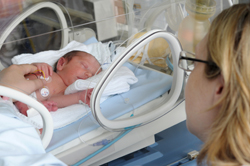SHARE WITH FRIENDS:
Premature birth
Premature birth is a relatively common occurrence, occurring in 7-11% of all pregnancies.Officially, this pregnancy is defined as a birth that occurs before 37 weeks of gestation.
A number of health-related complications can occur in premature babies. However, advances in early birth management mean that survival rates are very high, especially for children as young as 30 weeks.
Even before this stage, babies who are able to transition to 26 weeks of gestation still have about a 60% chance of surviving.
It can be very difficult to determine why a premature birth occurred or why the membranes ruptured. Many times premature birth passes as “one of those things”.
What starts labor anyway?
The answer is that we don’t really understand the mechanisms at the onset of labor. The baby is thought to be responsible for sending a hormonal message, which serves as a catalyst for the onset of complications. This can be caused by the baby’s lungs because they are ready to start breathing independently and no longer trust the umbilical cord to deliver oxygenated blood to them. Another theory is that the placenta secretes hormones or the mother’s vagina and cervix produce a certain amount of protein before labor begins.
Risk factors for preterm birth
There are a number of factors that increase the chances of a baby being born prematurely, but this is not absolute:
-
Maternal health conditions such as preeclampsia, gestational diabetes, autoimmune disease, uterine, urinary tract or other systemic infections
-
Smoking, illegal drug use, drinking alcohol
-
Previously, the birth of a premature baby increased the risk of its recurrence
-
Many pregnancies increase the chances of getting pregnant
-
Maternal malnutrition, inadequate weight gain, or, in turn, overweight during pregnancy
-
Placental abruption, placental abruption, prenatal bleeding
-
Periodontal disease
-
Premature birth is more common in women under the age of 17 and over the age of 35
Even in the absence of risk factors, children can be born prematurely. Nearly half of mothers who deliver their baby prematurely have no known risk factors.
Sometimes preterm birth is unavoidable, while other times it is deliberately planned. By continuing the pregnancy, complications can be initiated or initiated when the child (or mother) is at greater risk. When this happens, the cost and benefit equation is weighed. The uterus is not always the safest place for children.
Membranes can be artificially ruptured membranes (ARM) by an obstetrician or midwife in the maternity ward, and sometimes Synthocinone can be instilled. It is a hormone that causes the uterus to contract and begin labor. Vaginal delivery is most common if the baby is not disturbed or the birth is over; in which case the baby will be born by caesarean section.
Complications by cesarean section can be planned ahead of schedule. For example, if the mother is in a bad condition, has preeclampsia, diabetes, or placental insufficiency, then a cesarean may be the safest option, even if the baby has not yet reached full term.
Signs and symptoms of preterm birth
-
Spontaneous onset of uterine contractions before full term
-
Membranes should rupture early before the baby is born
-
Vaginal bleeding
-
Back pressure
-
The cervix should expand before the baby is born
Note: For mothers who have had children before, it is common for the cervix to partially dilate by the end of pregnancy.
A risk to the health of a mother who gives birth prematurely
-
Bleeding and infection
-
Emotional distress because the baby is born earlier than expected and unprepared
-
Possible interruptions in bonding and bonding, especially if the baby is taken for special care
-
It is common to require delivery by cesarean section or forceps delivery. The heads of premature babies are very soft and they need protection when they fall below the mother’s birth canal. Even if the baby’s head is small, the mother may still require an episiotomy. It is common for obstetricians to use forceps during childbirth for a premature baby, as this helps to control the delivery of the head and prevent it from coming out too quickly.
A health risk to a premature baby
-
Juvenile lungs and respiratory organs mean they may need ventilation. Hyaline membrane disease is rare in premature infants.
-
Intestinal problems such as necrotizing enterocolitis, infection, cerebral hemorrhage, and bleeding
-
The difficulty in maintaining its temperature due to the immaturity of the temperature-regulating centers in the brain
-
Drowsiness and fatigue that can affect nutrition
-
Problems with maintaining blood sugar levels; may vibrate and require additional kilojoules to replace it
-
A small amount of subcutaneous fat, which then affects the baby’s warmth. Typically, babies lose 7 percent of their birth weight in the first two weeks after birth. In premature babies and those with low levels of fat, this can be as significant as 7%.
-
Difficulty for parents working with their baby. Premature babies can look very small and fragile, and this can affect parental confidence and enjoyment. Potentially, there may be emotional relationship and communication problems due to the separation of the baby and the mother due to special care.
-
Delay in initiating successful breastfeeding.
What can I do to stop going to work prematurely?
-
Get regular, healthy antenatal care during the recommended stages of pregnancy.
-
Avoid being overweight. On average, 12 kg during pregnancy.
-
See your dentist at least once during pregnancy, brush your teeth at least twice a day, and floss. Infected gums produce prostaglandins - hormones that trigger labor.
-
If you feel the onset of labor before the full period, you should be examined by an obstetrician or midwife.
-
If you have any of the risk factors listed above, be aware that your baby may be born prematurely.
